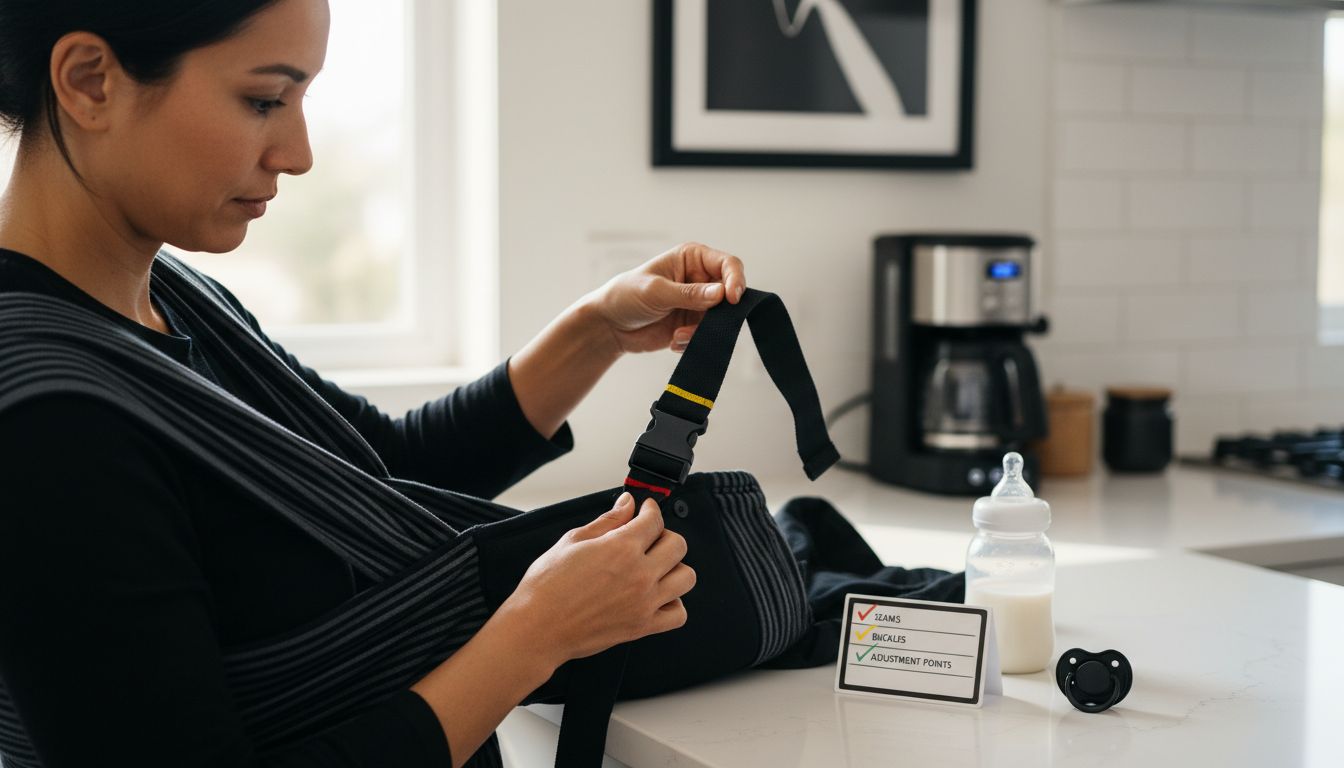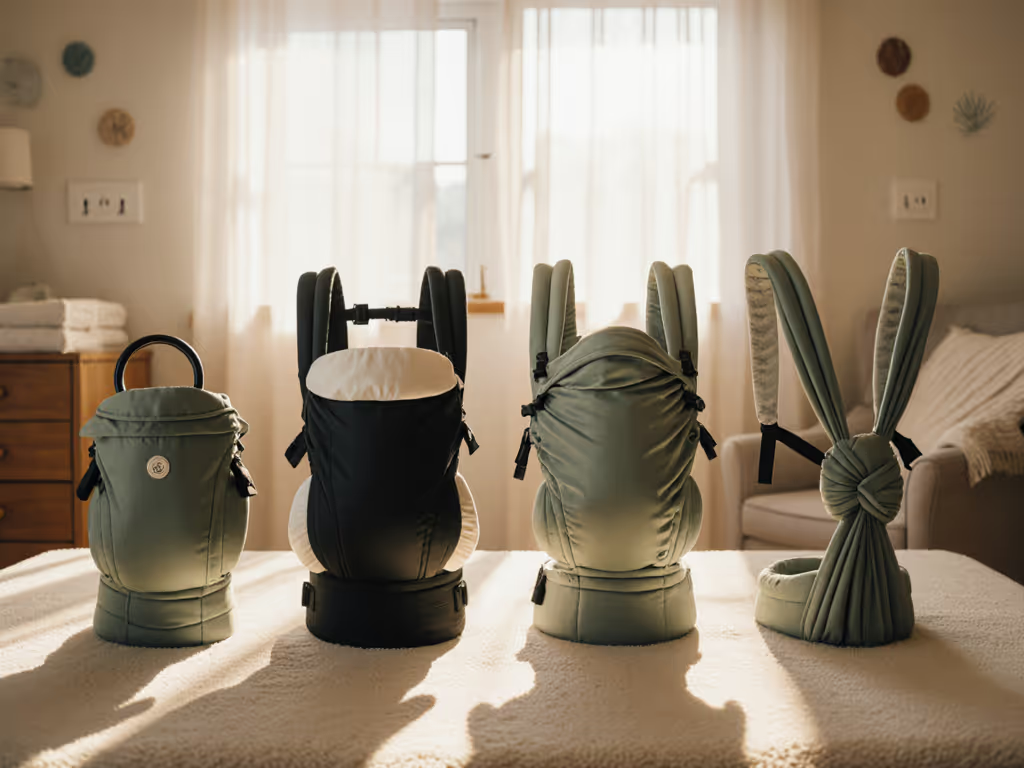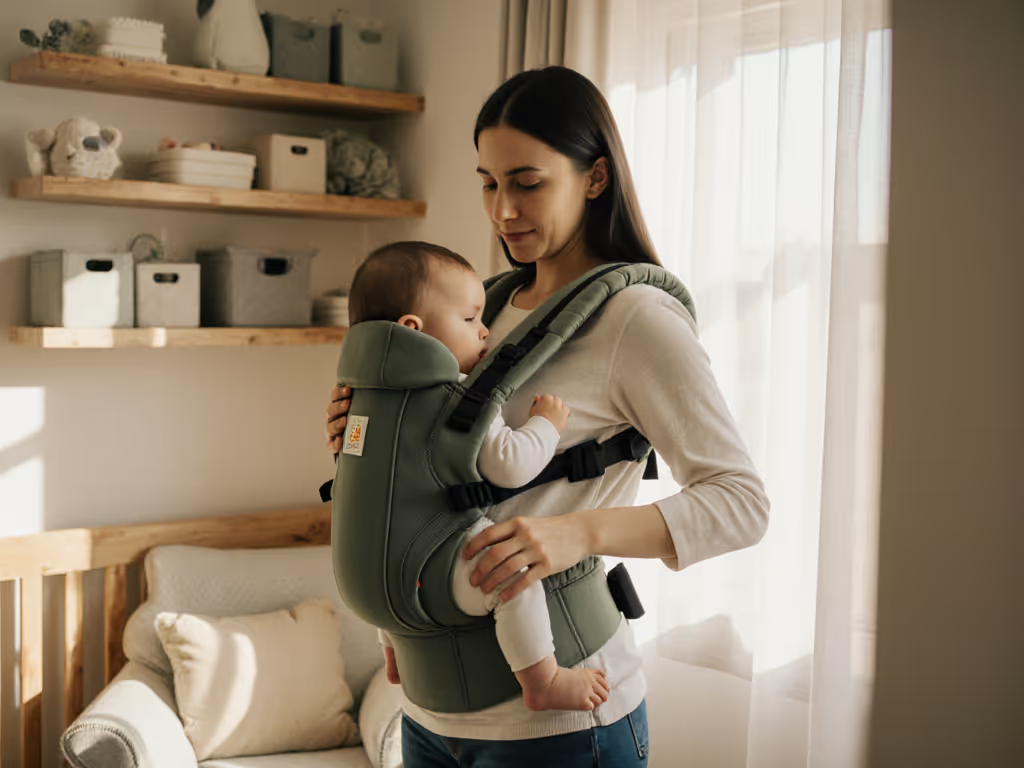
Master the Newborn Babywearing Process Safely and Easily

Did you know that over 80 percent of parents say using a baby carrier helps them feel more connected to their newborn? Finding the right carrier and learning safe babywearing techniques can make everyday life smoother while keeping your little one close and content. From safety checks to perfect positioning, these tips empower you to carry your baby confidently and comfortably from day one.
Quick Summary
| Key Point | Explanation |
|---|---|
| 1. Select a newborn-specific carrier | Choose carriers designed for infants under six months, ensuring proper neck and spine support in the "M" position. |
| 2. Conduct safety checks before use | Inspect all straps and attachment points for integrity, practicing adjustments without your baby for safety. |
| 3. Follow the T.I.C.K.S. rule | Ensure your baby is Tight, In view, Close enough to kiss, with chin off the chest for airway safety. |
| 4. Adjust straps for a comfortable fit | Secure straps symmetrically for even weight distribution, making incremental adjustments based on comfort and movement tests. |
| 5. Periodically check alignment during use | Regularly observe your baby’s position for proper back and leg alignment, addressing any signs of discomfort immediately. |
Step 1: Select the ideal carrier for your newborn
Selecting the perfect baby carrier for your newborn is more than just picking a cute accessory its about finding a safe supportive solution that makes both you and your baby comfortable. The right carrier transforms how you move through your day keeping your little one close while freeing up your hands for other tasks.
When searching for the ideal carrier most experts recommend prioritizing three key factors: newborn support neck and spine alignment and ease of use. Look for carriers specifically designed for infants younger than six months featuring narrow seats that naturally position your babys legs in the frog like "M" position recommended by pediatric orthopedists. Soft structured carriers or wrap style carriers work best for newborns offering maximum body contact and preventing hip dysplasia.
A pro tip from pediatric wearing specialists wear the carrier around your home first to practice adjustments and understand how your baby responds. Some babies love being snuggled close while others might need time to adjust. Pay attention to your newborns comfort signals like squirming or fussing which can indicate the carrier needs slight repositioning. The goal is creating a secure feeling that mimics the warmth and safety of being held in your arms.
As you move forward youll want to practice putting on your carrier multiple times building confidence and muscle memory before venturing out in public. Your next step will involve learning proper positioning techniques to ensure your newborns safety and comfort.
Step 2: Prepare your carrier and check safety features
Preparing your baby carrier is a critical safety ritual that requires careful attention and systematic checking. This step transforms your carrier from a simple piece of fabric into a secure transportation system for your most precious cargo.
According to the Baby Carrier Industry Alliance safety guidelines start with a comprehensive visual and tactile inspection of your carrier. Check every single attachment point fabric integrity and structural components. Look for any signs of wear fraying threads loose stitching or material weakness.
 Pay special attention to buckles straps and load bearing seams ensuring they can withstand your babys weight and your movements. For fabric carriers perform a gentle stretch test to confirm the material maintains its structural integrity and provides adequate support.
Pay special attention to buckles straps and load bearing seams ensuring they can withstand your babys weight and your movements. For fabric carriers perform a gentle stretch test to confirm the material maintains its structural integrity and provides adequate support.
A crucial safety protocol recommended by infant safety experts involves practicing carrier adjustments without your baby first. Simulate different scenarios like bending sitting and walking to understand how the carrier moves and responds to your body. Test weight distribution and adjust straps to create a snug yet comfortable fit across your shoulders and back. Warning signs include excessive sliding shifting or areas of significant tension that could compromise both your comfort and your babys positioning. Some carriers have color coded or numbered adjustment points specifically designed to help parents achieve the perfect fit quickly and confidently.
As you become more comfortable with your carriers safety features youll develop an intuitive understanding of its nuances. Your next step will involve learning precise positioning techniques to ensure your newborns optimal comfort and security.
Step 3: Position your newborn for optimal support
Positioning your newborn in a carrier is an art that combines safety science with parental intuition. Your goal is creating a secure environment that supports your babys natural body alignment while keeping them comfortably close to you.
Following the internationally recognized T.I.C.K.S. rule experts recommend ensuring your newborn is positioned with specific critical considerations. Tight means no extra fabric or loose areas that could compromise stability. In view requires you can always see your babys face clearly without moving fabric. Close enough to kiss indicates your baby should be positioned high enough on your chest that you could easily kiss the top of their head. Keep your newborns chin off their chest to maintain an open airway a crucial safety requirement. Support their back by ensuring the carrier provides a natural curved position that mimics how they would rest in your arms.
A professional tip from pediatric physiotherapists involves practicing positioning in front of a mirror to understand how subtle adjustments impact your babys alignment. Watch for signs of comfort like relaxed breathing and a calm demeanor. Warning signs include visible struggling difficulty breathing or an awkward neck position. Some carriers come with built in newborn inserts that help maintain proper positioning especially for smaller infants. Remember every baby is different so patience and gentle adjustments are key to finding the perfect carrying position.
![]()
As you become more confident in positioning your newborn youll develop an instinctive understanding of their comfort and safety. Your next step will involve learning how to move and transition while wearing your baby securely.
Step 4: Secure and adjust straps for a perfect fit
Securing and adjusting your baby carrier straps is a crucial skill that creates the foundation for safe and comfortable babywearing. Your goal is achieving a personalized fit that distributes weight evenly and keeps your newborn snug and secure.
According to babywearing safety experts start by standing in front of a mirror and systematically checking your strap configuration. Begin with shoulder straps ensuring they are symmetrical and sit comfortably without digging into your shoulders. Adjust the chest strap to sit at mid chest level creating a balanced weight distribution that prevents unnecessary strain. For back support focus on tightening waist straps first which act as the primary anchor point for your carrier. A well fitted waist strap should sit just above your hip bones creating a stable platform that transfers your babys weight efficiently.
A professional tip from ergonomic babywearing specialists involves performing a quick movement test after initial strap adjustment. Gently bounce bend and walk around to confirm the carrier maintains its position without sliding or shifting. Watch for any areas of tension or discomfort and make incremental adjustments. Warning signs include straps that create pinching sensations uneven weight distribution or areas where the carrier feels unstable. Some modern carriers feature color coded adjustment points or numbered indicators to help parents achieve precise fitting quickly and confidently.
As you become more proficient with strap adjustments youll develop muscle memory and an intuitive understanding of your carriers unique characteristics. Your next step will involve learning how to safely transfer your baby in and out of the carrier.
Step 5: Check alignment for comfort and safety
Checking your newborns alignment in the carrier is a critical safety practice that requires careful attention and systematic observation. Your goal is creating an environment that supports your babys natural body mechanics while preventing potential discomfort or strain.
Following the internationally recognized T.I.C.K.S. rule experts recommend performing a comprehensive alignment check that focuses on multiple body zones. Start by ensuring your babys back remains in a natural curved position preventing any unnecessary straightening or rigidity. Check that their head is supported and positioned so their chin remains off their chest which helps maintain an open airway. Verify that their legs are spread in a natural frog like position with knees slightly higher than their bottom creating an ergonomic seated stance that supports healthy hip development.
A professional tip from pediatric physiotherapists involves conducting periodic comfort checks during your babywearing session. Observe your newborns breathing pattern looking for smooth regular breaths that indicate proper positioning. Warning signs include visible struggling irregular breathing or signs of distress such as turning red or becoming unusually quiet. Some carriers include built in alignment guides or markers that can help parents quickly assess proper positioning. Pay special attention to subtle body language signals your baby might communicate suggesting they need a minor adjustment or repositioning.
As you become more intuitive about reading your babys comfort cues youll develop a natural ability to make real time adjustments. Your next step will involve learning how to confidently move and transition while maintaining optimal carrier alignment.
Make Newborn Babywearing Safe and Comfortable Today
Mastering the newborn babywearing journey means overcoming challenges like finding the right carrier, securing perfect positioning, and ensuring your baby’s safety and comfort. This article highlights key concerns such as newborn support, proper alignment following the T.I.C.K.S. guidelines, and adjusting straps for a perfect fit. If you want to feel confident and secure while carrying your newborn in a way that promotes healthy development, addressing these pain points is essential.
Take the next step with Caregiver Carry, your trusted resource for evidence-based babywearing guidance. Explore detailed safety checklists, expert-approved carrier reviews, and step-by-step instructions for ideal newborn positioning. Don’t wait to ensure your baby’s comfort and security. Visit Caregiver Carry now and discover how to transform babywearing into a joyful, safe experience for both of you.
Frequently Asked Questions
How do I select the right baby carrier for my newborn?
Choosing the right baby carrier involves prioritizing newborn support, neck and spine alignment, and ease of use. Look for carriers designed for infants under six months and practice wearing it around your home to see how your baby responds to it.
What safety features should I check before using a baby carrier?
Inspect your baby carrier thoroughly by checking attachment points, fabric integrity, and structural components. Conduct a gentle stretch test on fabric carriers and practice adjustments without your baby to ensure a snug fit before actual use.
How do I position my newborn correctly in a carrier?
Follow the T.I.C.K.S. rule: ensure a tight hold, visible face, close enough to kiss, chin off the chest, and proper back and leg support. Use a mirror to help adjust positioning and pay attention to your newborn's comfort cues for optimal support.
What steps should I follow to adjust baby carrier straps?
Start by checking the symmetry of shoulder straps and adjusting the chest strap for balanced weight distribution. After initial adjustments, perform a movement test by gently bouncing or bending to confirm the carrier remains secure and comfortable.
How can I know if my newborn is aligned comfortably in the carrier?
Check that your baby's back is in a natural curve and their chin is off their chest for an open airway. Observe your baby's breathing and comfort signals, making minor adjustments as needed to prevent strain or discomfort.
What should I do if my baby shows signs of discomfort while being worn?
If your baby shows signs of discomfort such as fussiness or difficulty breathing, ensure they are positioned correctly according to the T.I.C.K.S. rule. Make gradual adjustments and observe their body language, ensuring they are supported properly within the carrier.



